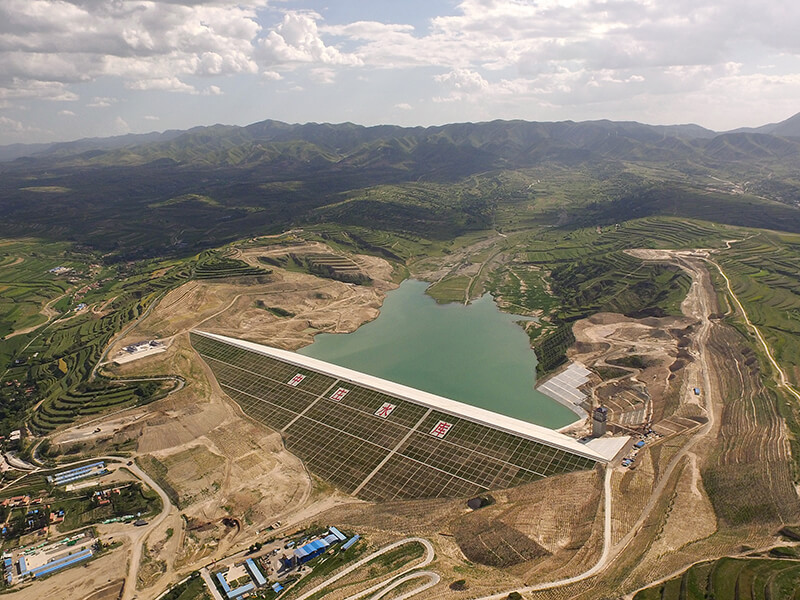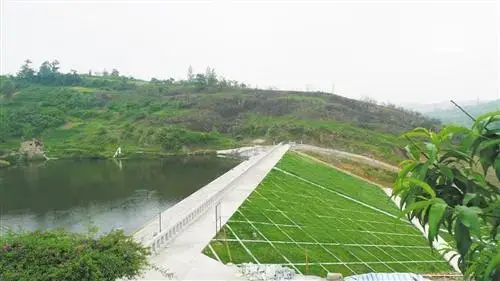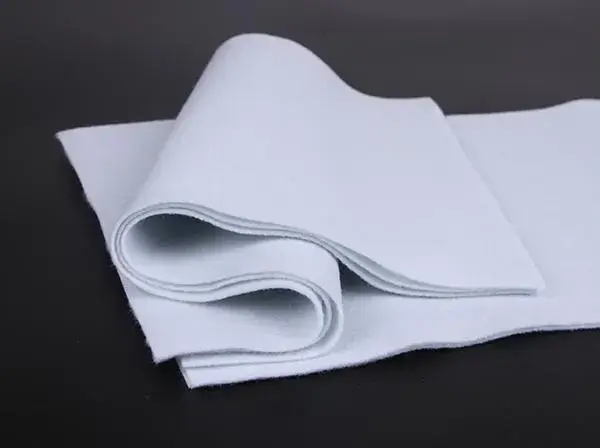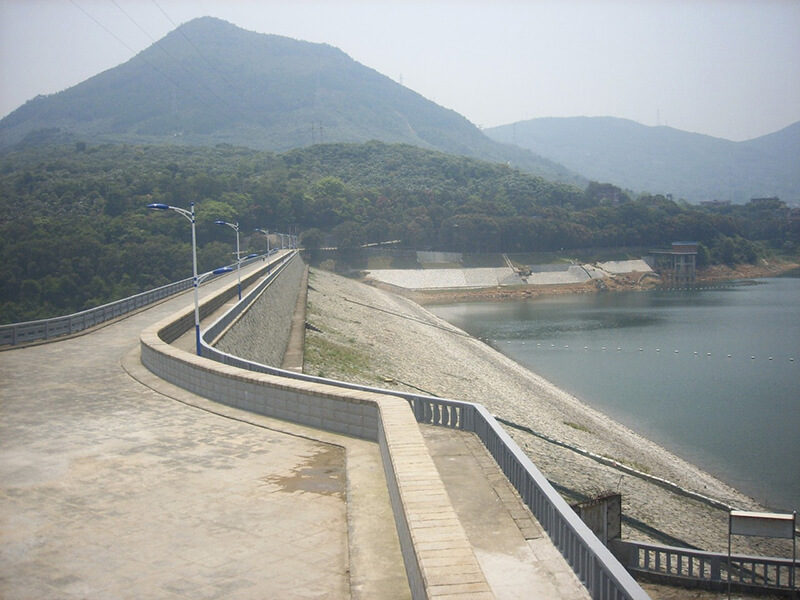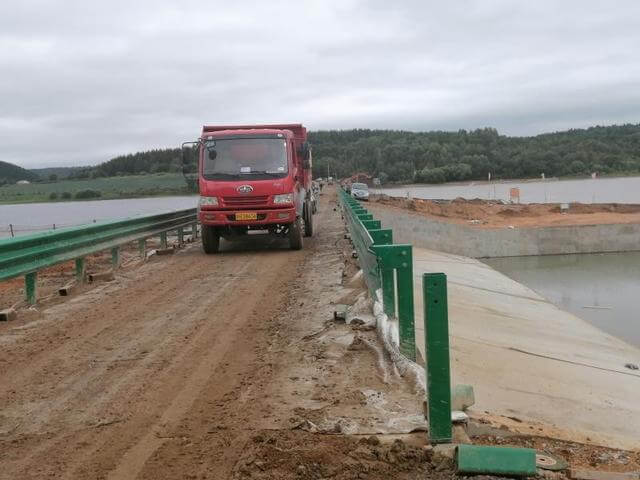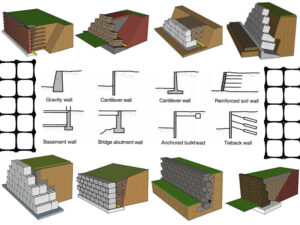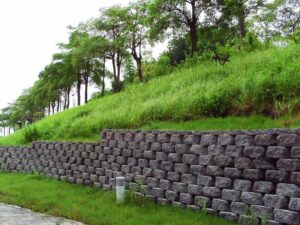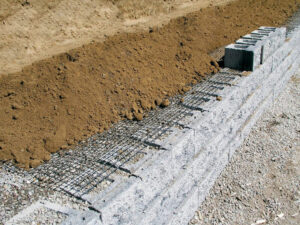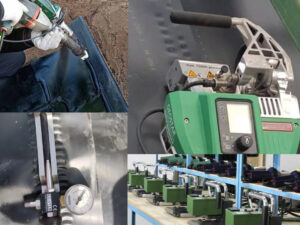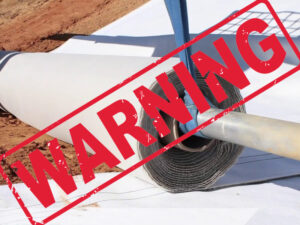A certain dam was completed in August 1955, with a designed storage capacity of 13.5 million m3, a dam height of 21.15 m, and a dam crest elevation of 1870 m. Because the dam foundation has a soft soil layer, the main dam is an arched homogeneous earth dam that curves upstream, 660 m long, and there are two auxiliary dams, 1128 m long, and the total length of the dam axis is 1788 m.
Because the dam is located on the Tertiary sandy silt and fine sand layers, no foundation treatment was carried out, resulting in numerous water leaks, sand gushing and dam slope collapse after the reservoir was built. Although treated many times, it could not be cured.
Many years later, based on detailed investigation, remedies were proposed. A geotextile filter cloth layer was used to replace the traditional gravel filter layer in the 120 m upstream dam slope cushion and the 181 m downstream drainage ditch in the main dam river bed section for drainage and erosion control.
After professional laying by the engineering team, it includes 7630 m2 of upstream dam slope cushion, 1460 m2 of downstream drainage ditch, 14770 m2 of main dam upstream quilt surface, and a total of 23860 m2 of geotextile fabric laid. After years of normal operation, the main dam has not seen any abnormalities so far.
Earth Dam Design Analysis
1) Earth dam seepage calculation
In order to understand the distribution of seepage flow field in the reservoir earth dam, two-way electrical simulation tests and finite element method numerical analysis were conducted on the 0+390 and 0+460 sections of the earth dam.
2) Geotextile filter layer test.
This engineering test uses needle-punched non-woven geotextiles to conduct system water permeability tests with soil materials (silty clay, sandy soil and sand) to measure the changes in water permeability of the base soil and fabric system over time. The calculation results show that the geotex fabric can meet the requirements and can be used as a filter layer.
3) Geotextile strength analysis.
For geotextile filter layers, it mainly depends on the pore size of the fabric and its water permeability. Using the bursting and puncture formulas for verification, the geotextile filter fabric can meet the actual operating conditions of the reservoir earth dam.
Geotextile engineering layout
1. Downstream reverse filter layer
This reservoir earth dam uses needle-punched non-woven geotextile (thickness 4.58 mm) as the back filter body in three places:
1) No. 4 reverse filter body is located at the foot of the main dam, with a total length of 180 m.
2) The head of the No. 2 back filter body intersects vertically with the No. 1 back filter body. Since the conventional gravel filter body has a final section of 52.1 m, geotextile cannot be directly laid on it. Therefore, a 3.25 m gravel filter section was first built, and the geotextile cloth filter layer was laid with a length of 26.65 m.
3) The No. 6 back filter body is a flat back filter structure, 9 m long and 6 m wide. It is located at the old river bed at the foot of the main dam. The old river bed is 5 m deep with sand and pebbles and a clay layer underneath.
2. Dam surface slope protection
The main dam needs to be renovated for wave protection and slope protection on the dam surface, covering an area of 23,500 m2. The cushion layer is made of polyester needle-punched non-woven geotextile with a thickness of 3.5 m. Two types of face protection materials are used at the same time. Dry-laying face protection is used on the left and right abutments and below 1862.5 m of the main dam. The surface of the main dam above 71862.5 m is protected by a series of concrete precast blocks.
Geotextile cloth construction technology
1. Construction of reverse filter body
The construction of the anti-filter body of this project should be completed in one excavation of the foundation pit.
During construction, geotextiles are first laid from both ends of the foundation pit to the middle, and pebbles are filled in while laying.
To prevent construction workers from stepping on and being exposed to the sun, the geotextile fabric on the top of the pit needs to be covered with a straw curtain. To prevent the mud on the dam surface from being filled with pebbles and affecting the water flow, coarse sand and stones are laid on top of the pebbles, and then covered with rubble to protect the surface.
The construction of the reverse filter body is completed according to the cross-section required by the design.
2. Slope construction
1) Dam surface renovation.
The main reservoir dam of this project has been in operation for more than 30 years. After the original slope protection stones, cushions, and surface weeds have been removed, comprehensive and precise measurements are required to adjust the slope and cut it according to the original design slope ratio.
If the depression needs to be filled up and compacted carefully to make the dam surface flat, the geo fabric cloth can be flatly attached to it. Only after the concrete blocks are laid, the dam surface will be neat and beautiful.
2) The laying of geotextile fabric and concrete blocks.
The geotech fabric is laid in sections from bottom to top along the vertical direction of the dam axis. Each section is about 8 to 12 m long, that is, 2 to 3 pieces of geotextile are sewn together.
After the geo filter fabric is laid, the concrete blocks should follow immediately to minimize the exposure time of the geotextile to the sun until it is laid to the design elevation.
Embed the geotech filter cloth 30 cm into the trench of the dam body, and then nail 12 mm diameter steel drills every 2 m and anchor it in the dam body. Then fill the trench and compact it, and then the concrete blocks can be laid.
The concrete blocks are also laid from the bottom to the top of the dam, and the steel bars are pierced while laying. The ends of the steel bars are welded and tied tightly, and then buried on the wooden piles on the top of the dam. The gaps between the concrete blocks are filled with coarse sand, and then asphalt mortar is poured.
To make the dam’s surface beautiful, a layer of colored mortar can be applied to the surface of the asphalt mortar.
Project implementation effect
This reservoir earth dam uses a geotextile filter layer instead of the traditional gravel filter layer. After the completion of the project, the swamp at the foot of the dam dried up immediately, the outlet of the filter body was clear, and the drainage filtration effect was remarkable.
The practice has proved that in the absence of ideally graded natural gravel materials, the use of geotextile filter layers has the advantages of simple construction, easy control of construction quality, fast construction progress and saving of project investment compared with conventional gravel filter layers. It can shorten the construction period by more than half and save about 1/3 of the project investment.

